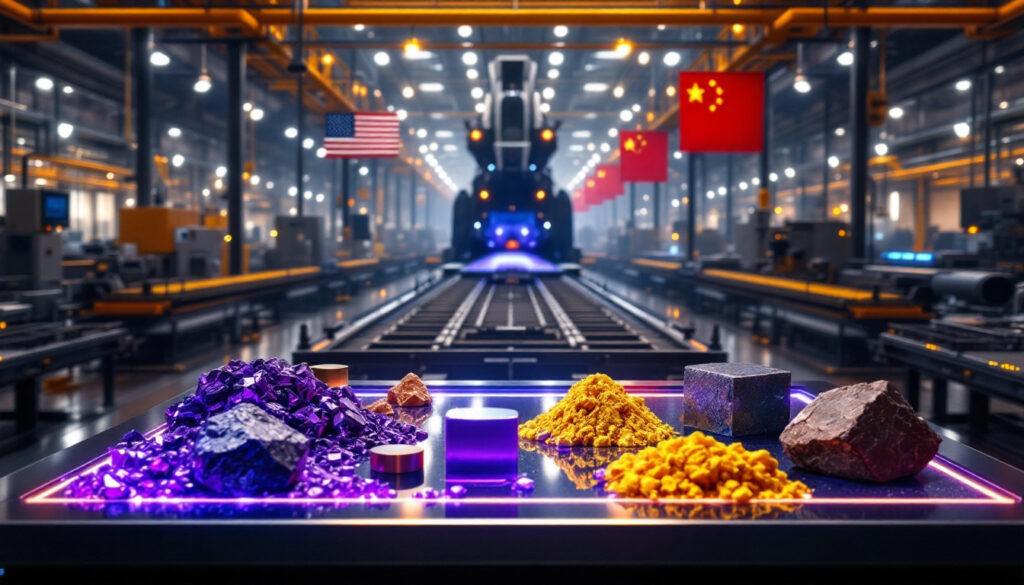US Critical Minerals Tariff Investigation: National Security Implications and Economic Impact
The US Government's recent executive order under Section 232 of the Trade Expansion Act of 1962 marks a pivotal shift in addressing national security risks posed by critical mineral shortages. This investigation represents a strategic move to evaluate and potentially restructure America's approach to securing essential resources amid growing global competition and supply chain vulnerabilities.
Understanding the Executive Order
President Donald Trump has launched a Section 232 investigation examining whether critical mineral imports pose significant risks to national security. This decisive action requires Commerce Secretary Howard Lutnick to conduct a comprehensive 180-day review, with findings due by October 2025.
The investigation's scope specifically targets processed critical minerals including cobalt, nickel, rare earth elements (REEs), and uranium – resources foundational to both defense systems and modern technology. Unlike raw materials, the executive order emphasizes "processed critical minerals" including oxides, oxalates, salts, and metals which require sophisticated refining capabilities the US currently lacks domestically.
"This investigation addresses a critical vulnerability in America's industrial base," noted Secretary Lutnick. "When 95% of certain processed minerals come from or through potential adversaries, our national security stands on precarious ground."
Any resulting tariffs could potentially override the reciprocal tariffs established earlier this month, signaling the administration's prioritization of mineral security over previous trade arrangements.
Why Are Critical Minerals Strategically Important?
Critical minerals form the literal foundation of American national security infrastructure. These resources enable everything from precision-guided munitions and aircraft to communications systems and cyber defense capabilities.
The modern F-35 fighter jet contains approximately 920 pounds of rare earth metals, while a single Virginia-class submarine requires specialized alloys containing cobalt, nickel, and other critical elements. Without secure supply chains for these materials, defense readiness faces significant risk.
America's processing vulnerability represents perhaps the most concerning aspect of the current situation. While the US maintains some mining capacity, domestic processing facilities remain scarce. Only three active rare earth processing facilities operate in the United States, compared to China's network of over 120 facilities.
"The distinction between mining and processing is crucial," explains Dr. Emily Zhang of MIT Materials Laboratory. "Even when we extract these minerals domestically, we often ship them overseas for processing before reimporting the finished materials – creating a dangerous dependency loop."
Defense applications highlight the irreplaceable nature of these resources. Rare earth magnets enable missile guidance systems, uranium market analysis shows its importance for powering naval vessels, and specialized alloys containing cobalt and nickel withstand extreme conditions in aerospace applications.
What Is Driving This Investigation?
China's Market Dominance
China's export restrictions on rare earth materials by 40% in the first quarter of 2025 sent shockwaves through global supply chains. This restriction came as a direct response to previous American tariff actions and demonstrated China's willingness to leverage its mineral dominance as a geopolitical tool.
The market response was immediate, with prices for neodymium and dysprosium – critical for high-performance magnets – spiking over 60% within weeks. American technology manufacturers faced difficult decisions about production schedules and pricing.
China maintains overwhelming supply chain control across multiple critical minerals:
- 90% of global cobalt refining capacity
- 70% of lithium processing
- 85% of rare earth separation and refining
- 75% of graphite processing for battery anodes
"China's dominance isn't accidental," notes trade analyst Sarah Johnson. "It represents decades of strategic investment and acquisition that the US is only now beginning to counter."
Domestic Production Limitations
The United States faces substantial barriers to rapidly expanding domestic critical mineral capacity. Currently, only a limited number of mines and even fewer processing facilities operate within US borders.
Establishing new mining operations typically requires 7-10 years from exploration to production – nearly three times longer than in countries like Australia or Canada. This extended timeline stems from complex permitting processes, environmental reviews, and capital formation challenges.
Regulatory hurdles present particularly significant obstacles. The average mining permit in the US requires navigating 30+ federal, state, and local agencies with overlapping jurisdictions. By comparison, similarly environmentally-conscious nations like Australia complete comparable processes in under three years.
"The regulatory framework wasn't designed for today's urgency," explains mining executive Robert Chen. "When facing a strategic competitor with a multi-decade head start, our process-heavy approach creates structural disadvantages."
Broader US Minerals Strategy
The administration is pursuing a multi-faceted approach to mineral security beyond tariff consideration. Mine approval acceleration represents a core focus, with efforts to streamline the permitting process through executive action and potential legislative reforms.
Federal land identification initiatives have designated 12 million acres for potential mineral exploration, focusing on regions with known deposits of lithium, cobalt, and rare earths. Many of these sites exist on previously disturbed lands, reducing environmental concerns.
Tariff loophole closure addresses sophisticated circumvention tactics. According to global commodities insights, approximately 30% of Chinese-originated critical minerals enter the US through third countries like Vietnam and Malaysia, often with minimal processing to avoid country-of-origin restrictions.
"Supply chains are incredibly adaptive," notes Senator Lisa Murkowski. "We need comprehensive strategies that address not just the front door but all potential side entrances for vulnerable materials."
The economic resilience focus aims to reduce dependency through multiple pathways: increased domestic production, diversified international sourcing, strategic stockpiling, and accelerated recycling of critical minerals from electronic waste and industrial byproducts.
Potential Economic Impacts
New tariffs would create complex ripple effects throughout American manufacturing. Companies using these minerals would likely face cost increases between 15-20% in the short term before supply chains adjust.
The impact would be particularly pronounced in electric vehicle production, where critical minerals constitute approximately 40% of battery costs. Manufacturers including Tesla and General Motors have already begun negotiating alternative supply arrangements with producers in Australia, Canada, and South America.
Supply chain restructuring would accelerate existing trends toward "friend-shoring" – relocating supply chains to allied nations rather than potential adversaries. This shift brings both challenges and opportunities, with higher short-term costs but potentially greater long-term resilience.
"Companies face difficult trade-offs between immediate cost pressures and long-term security," explains BloombergNEF analyst Maria Santana. "Those who invested in supply chain diversification years ago now have significant competitive advantages."
Investment opportunities would emerge for domestic mining and processing companies. The MP Materials Mountain Pass mine in California, America's only significant rare earth producer, would likely see substantial valuation increases, along with emerging lithium projects in Nevada and North Carolina.
International trade relations would face additional complexity, particularly with China. Previous Section 232 actions on steel and aluminum triggered retaliatory measures from trading partners, though critical minerals represent a more specialized market with fewer substitution possibilities.
What Are Critical Minerals?
The Department of Energy's 2025 Critical Minerals List identifies 50 resources considered vital for American energy and defense applications. Key examples include:
Cobalt plays an essential role in high-performance batteries and superalloys for jet engines. Approximately 70% of global cobalt production comes from the Democratic Republic of Congo, where Chinese firms control 80% of mining operations.
Nickel is crucial for stainless steel production, batteries, and specialized alloys that maintain integrity under extreme conditions. Indonesia and the Philippines account for over 45% of global nickel mining, though processing remains dominated by Chinese facilities.
Rare earth elements comprise 17 metals with unique magnetic, luminescent, and catalytic properties. Despite their name, these elements are relatively abundant but rarely concentrated in economically viable deposits. They enable technologies from smartphone vibration motors to precision-guided weapons.
Uranium provides fuel for naval propulsion and civilian energy generation. Currently, 95% of uranium used in US nuclear reactors comes from imports, primarily from Canada, Kazakhstan, and Australia.
Strategic applications span virtually every critical technology sector. Defense systems rely on rare earth magnets for guidance systems, specialized alloys for aircraft engines, and numerous other applications where performance requirements demand specific material properties.
Renewable energy technologies require substantial mineral inputs – a typical wind turbine contains up to 600 pounds of rare earth elements, while solar panels utilize gallium, indium, and other critical minerals.
Growing demand, driven by both defense needs and clean energy transition, creates projected supply gaps in multiple critical minerals by 2030. Lithium demand alone is expected to increase 500% by 2030, with current global production capacity meeting only 40% of anticipated needs.
FAQs About Critical Minerals and National Security
What makes certain minerals "critical"?
Minerals achieve "critical" designation based on four key factors:
Essential applications in national security and economic infrastructure: These minerals enable technologies where substitution would significantly degrade performance or reliability.
Supply chain risk due to concentrated production: When 50%+ of global supply comes from a single country, vulnerability increases dramatically.
Lack of viable substitutes: Unlike commodities such as steel or aluminum, many critical minerals have unique properties that cannot be replicated with alternative materials.
Vulnerability to geopolitical supply challenges: Minerals sourced from politically unstable regions or strategic competitors face higher disruption risks than those from allied nations.
How dependent is the US on imported critical minerals?
The United States maintains near-total import dependence for multiple critical minerals:
- 99% of lithium (primarily from Chile, Argentina, and China)
- 100% of graphite for battery anodes (78% from China)
- 80% of rare earth elements (primarily from China)
- 75% of cobalt (primarily through Chinese-controlled supply chains)
This dependency creates vulnerability both through intentional supply disruption and market concentration. Price volatility becomes particularly problematic for defense procurement, where budgeting cycles struggle to accommodate rapid material cost changes.
"Our dependency isn't just about raw materials," explains defense procurement specialist James Harris. "It's the entire value chain from mining through processing to component manufacturing that creates strategic vulnerability."
What industries would be most affected by new tariffs?
Defense contractors would face immediate challenges, particularly for specialized materials used in next-generation weapon systems and communications. Companies like Lockheed Martin, Raytheon, and General Dynamics have already begun strategic stockpiling of critical materials.
Electric vehicle manufacturers would experience significant cost pressures. Tesla's Model Y contains approximately $3,500 worth of critical minerals, with potential tariffs increasing this by $500-700 per vehicle. This cost pressure comes at a pivotal moment in EV market development.
Electronics producers dependent on rare earths for motors, speakers, and other components would likely accelerate diversification efforts already underway following previous supply disruptions. Apple and Samsung have led initiatives to recover rare earths from recycled devices.
Renewable energy developers face particular challenges with wind turbine magnets and photovoltaic materials. NextEra Energy estimates tariffs could increase utility-scale solar installation costs by 12-18%, potentially delaying projects already contracted at fixed prices.
Timeline and Next Steps
The investigation period will continue through October 2025, with the Commerce Department gathering data from both industry and security perspectives. Initial findings are expected by late summer.
Public comment opportunities will open in August 2025, with over 30 industry hearings scheduled across manufacturing centers. According to the White House fact sheet, previous Section 232 investigations received thousands of public comments, with particular focus on downstream effects and unintended consequences.
The recommendation phase will follow the investigation's conclusion, with potential outcomes ranging from targeted tariffs on specific products to broader import restrictions or domestic content requirements for government procurement.
Implementation timeline for any new measures would likely begin in January 2026, allowing affected industries approximately 90 days to adjust supply chains and contractual arrangements. Previous Section 232 actions on steel and aluminum followed similar timeframes.
"Whatever the outcome, companies should prepare for a fundamentally different approach to critical mineral supply chains," advises international trade attorney Michelle Lopez. "The era of optimizing solely for cost is giving way to a more nuanced balance between efficiency and security."
Ready to Stay Ahead of the Next Mineral Discovery Breakthrough?
Discover why major mineral discoveries can lead to significant market returns by exploring Discovery Alert's dedicated discoveries page, showcasing historic examples of exceptional outcomes and powered by the proprietary Discovery IQ model that gives investors a crucial edge in mineral exploration opportunities.




